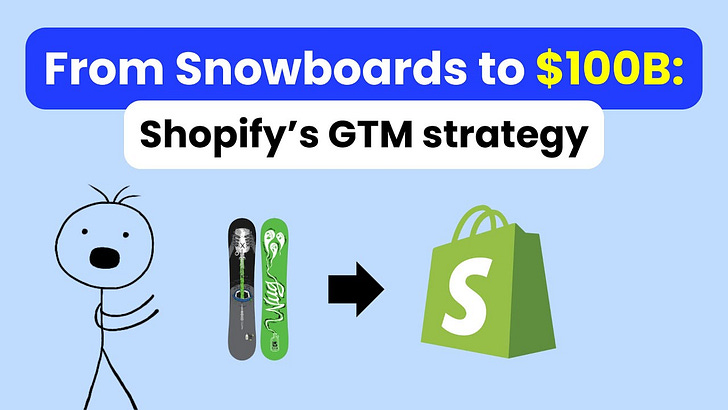From Snowboards to a $100B Empire: How Shopify Took Over E-Commerce
What product marketers and founders can learn from Shopify’s go-to-market strategy
Hello GTM friends 👋
This week, we’re unpacking how Shopify turned a personal frustration into one of the most powerful e-commerce platforms on the planet and what you can take away from their go-to-market playbook.
🎥 Prefer to watch? Check out the video version here:
Or read on for the full breakdown.
Shopify’s Go-To-Market Story
Shopify didn’t start with a pitch deck or a moonshot vision. It started with a problem.
In 2004, Tobias Lütke just wanted to sell snowboards online. But every tool he tried—Yahoo Stores, OSCommerce, Miva—felt clunky, outdated, and limiting.
So he built something better.
That side project became Shopify.
Solving a Problem You Know Intimately
Tobias was a developer first. Instead of wrestling with bad software, he wrote his own. A storefront platform built with Ruby on Rails that actually worked the way he wanted.
Word spread quickly.
Other entrepreneurs started asking if they could use it too.
So in 2006, Tobias and his co-founders shut down their snowboard shop—and launched Shopify.
It was simple but powerful:
Customizable templates
Built-in payments
Easy order tracking
But most importantly: it launched at the right time.
E-commerce was rising again post-dot-com crash, and more people were starting businesses online.
GTM Play #1: Go Where Your Customers Already Are
Shopify’s first users weren’t random.
They came from the Ruby on Rails developer community, where Tobias had already built credibility.
That trust seeded an early beta waitlist with thousands of sellers.
Lesson: Start with the tribe you already belong to.
GTM Play #2: Build a Referral Engine
Instead of targeting individual store owners, Shopify went after designers and agencies—people building stores for others.
They offered 20% of lifetime revenue for each referred customer.
That gave freelancers and developers a reason to promote Shopify on every client project.
Lesson: Turn your partners into a growth channel.
GTM Play #3: Launch a Competition to Spark Virality
In 2008, Shopify launched the Build-a-Business Competition:
💰 $100,000 prize to the best business launched on Shopify within 6 months.
The results?
Over 1,000 new stores created
$3M in merchant revenue generated
Massive word-of-mouth momentum
Lesson: A good contest can do more than ads ever will.
2009: From Tool to Marketplace
Shopify’s next big move?
They opened up their API and launched the Shopify App Store.
Now, developers could build and sell plugins.
Merchants could fully customize their stores.
That move turned Shopify from a tool into a platform—and made the product stickier with each added integration.
More Growth Levers: The Shopify Flywheel
After that, Shopify kept stacking GTM plays:
Free SEO tools: Name generators, logo makers, policy templates. These drove 2M+ visits a year and fed top-of-funnel growth.
Educational content: Blogs, guides, podcasts, and courses that helped entrepreneurs grow—and positioned Shopify as a trusted advisor.
Aligned pricing model: Shopify made money only when merchants made money, via flat subscriptions and transaction fees.
Offline expansion: Shopify POS and Shopify Payments made it easy for merchants to sell in-person with out-of-the-box solutions.
Climbing upstream: In 2014, Shopify Plus launched to serve enterprise brands—unlocking bigger contracts and higher LTV.
From solo entrepreneurs to global giants like Unilever, Shopify kept expanding its surface area.
What You Can Learn from Shopify’s GTM Strategy
✅ Solve a problem you know deeply
Tobias built the tool he wished existed—and millions of others felt the same pain.
✅ Start with a tool, evolve into a platform
Opening up the API turned Shopify into a marketplace, unlocking network effects.
✅ Turn customers into your marketing engine
From referral programs to free tools to business competitions, Shopify made it easy (and rewarding) to spread the word.
✅ Align incentives with your users
Shopify’s model ensures it only grows when its merchants succeed.
If you found this breakdown helpful, drop a like and let me know:
👉 Which company should I break down next?
And if you’re looking to break into product marketing or level up your GTM skills, check out Product Marketing School—a hands-on, no-fluff course to help you launch your PMM career.
Till next time,
— Henry



